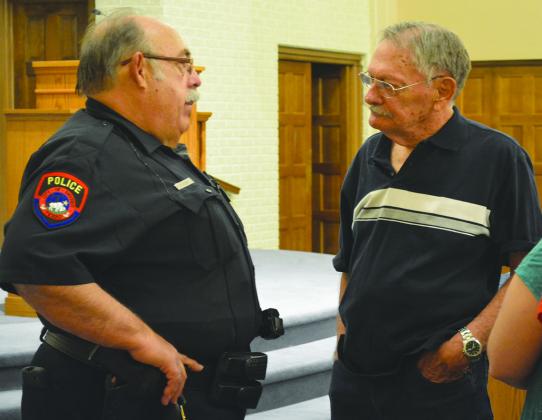“It’s not a case of ‘if.’ It’s a case of ‘when.’”
That is how Snyder police Officer Robert Clark Sunday greeted community members at a Civilian Response to Active Shooter Events (CRASE) training at 37th Street Church of Christ. The training teaches civilians how to respond during an active-shooter event, with the goal of increasing survivability.
The CRASE program defines an active-shooter event as involving one or more persons engaged in killing or attempting to kill multiple people in an area occupied by multiple unrelated individuals.
Clark said that these events don’t necessarily just include guns but also bombs, motor vehicles or other deadly weapons.
When these events occur, there are three states of disaster response that take place: denial, deliberation and a decisive moment.
“You don’t have time to deny what you’re hearing or seeing,” Clark said. “You have to deliberate and get out. Calm yourself, and control your breathing. Keep a script in your head of what you’re going to do, and once the decision of what you’re going to do is made, there is no sense in worrying about it. Just do it. The worst thing you can do is nothing.”
It’s important in these situations to take action, including knowing where the exits are and turning down cell phone ringers so that the shooter cannot locate you. Clark also said that hiding should never be an option.
“Don’t hide. Get out,” he said. “You can’t be a target if you’re not there. Hiding and hoping is not a plan. If they find where you’re hiding, you’re done.”
Clark said that on average it takes law enforcement three minutes to respond to emergency situations.
“What are you going to do in that three minutes?” he asked. “It’s longer than you realize.”
While waiting for law enforcement to arrive, there are three ways to be proactive in active-shooter events: avoid, deny and defend.
To avoid the situation, a person needs to leave the area as soon as possible and call 911.
If a person is unable to leave, they can deny the situation by locking the door, turning off the lights and staying out of sight. Inward opening doors can be barricaded with heavy objects or doorstops. Outward opening doors can be held in place with belts, ropes or extension cords.
If a shooter still enters the room, the final step is to defend yourself.
“Remember you’re fighting for your life,” Clark said. “It’s not over until it’s over. What you do matters. I don’t care how old, young, sick or tired you are. You are not helpless. You have to take it upon yourself to do what you can do to save your life and the lives of those around you. Your life depends on what you do.”
For more information about civilian response to active shooter events, visit www.avoiddenydefend.org.


